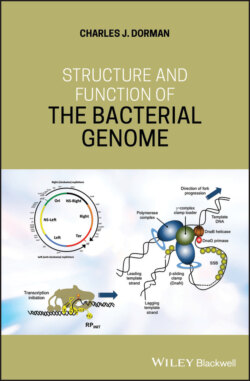Читать книгу Structure and Function of the Bacterial Genome - Charles J. Dorman - Страница 49
1.38 FIS and the Early Exponential Phase of Growth
ОглавлениеFIS is a homodimeric NAP that is encoded by the second gene in the dusB‐fis operon and shows strong homology to the DNA‐binding domain of the NtrC transcription factor (Bishop et al. 2002; Morett and Bork 1998). Transcription of the fis gene is maximal in the early stages of exponential growth and FIS plays an important role in boosting the expression of genes that encode components of the translational machinery of the cell (Appleman et al. 1998; Ball and Johnson 1991; Hirvonen et al. 2001; Osuna et al. 1995). FIS binds to the major groove of the DNA using a helix‐turn‐helix (HTH) motif that interacts with A+T‐rich sites that match a weak consensus sequence (Hancock et al. 2016). The protein uses an induced fit binding mechanism that compresses the minor groove between those parts of the major groove that accommodate the HTH motifs of the two subunits (Figure 1.18) (Hancock et al. 2016; Stella et al. 2010). This creates a bend in the DNA of 65° according to FIS‐DNA co‐crystal structure data (Stella et al. 2010) with bends of up to 90° also being reported (Kostrewa et al. 1992; Pan et al. 1996).
Transcription factors that introduce bends into DNA can facilitate additional contacts between DNA (including proteins bound to that DNA) located upstream of the promoter and bound RNA polymerase, increasing the efficiency of transcription initiation (Huo et al. 2006; Rivetti et al. 1999; Verbeek et al. 1991). FIS acts as a ‘conventional’ transcription factor at some promoters, making protein–protein contacts with RNA polymerase (Bokal et al. 1997) and its DNA‐bending activity has the potential to enhance the efficiency of the early stages of the transcription process. FIS can also influence promoter function without the need to contact RNA polymerase. The leuV operon consists of three genes that encode three of the four tRNA1Leu isoreceptors and its promoter is under the positive control of FIS. The single binding site for the FIS protein upstream of the leuV promoter is located in a DNA segment that is prone to becoming single‐stranded under the torsional stress imposed by negative supercoiling. This phenomenon is known as supercoiling‐induced DNA duplex destabilisation, SIDD (Benham 1992, 1993). Binding of the FIS protein to its site within the SIDD element displaces the tendency towards duplex destabilisation to the nearest susceptible site, in this case, the leuV promoter – assisting in the formation there of an open transcription complex (Opel et al. 2004). This mechanism is not peculiar to FIS and has been demonstrated for the IHF NAP too (Sheridan et al. 1998). It is likely to be used at many other promoters and represents an under‐researched aspect of the link between NAP binding, DNA topology, and promoter activation.
FIS has also been shown to create a nucleoprotein complex at promoters with a series of FIS‐binding sites that stabilise the topological state of the DNA in ways that favour transcription initiation (Rochman et al. 2004). Many of these promoters express genes that encode components of the translational apparatus, such as ribosomal proteins, tRNA, and rRNA (Champagne and Lapointe 1998; Newlands et al. 1992; Nilsson et al. 1990). Increased translation capacity is necessary to support rapid bacterial growth, so the stimulatory role of FIS during the lag‐to‐log phase of the growth cycle is important. Consistent with this is the observation that while mutants that lack the FIS protein remain viable, they display reduced competitive fitness when grown in co‐culture with their otherwise isogenic wild‐type parent (Schneider et al. 1997).
